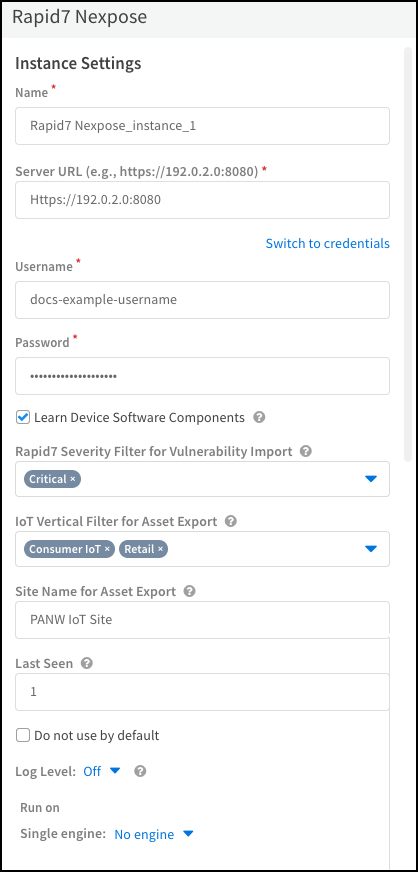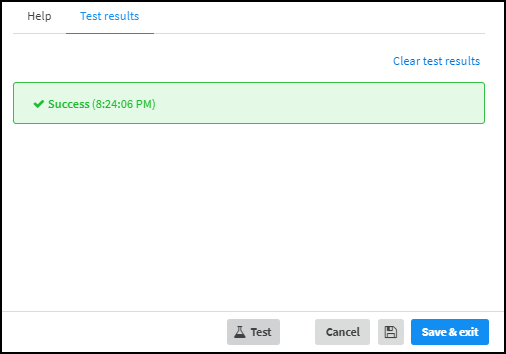IoT Security
Set up IoT Security and XSOAR for Rapid7 Integration
Table of Contents
Expand All
|
Collapse All
IoT Security Docs
Set up IoT Security and XSOAR for Rapid7 Integration
Set up IoT Security and Cortex XSOAR to integrate with Rapid7 for
vulnerability scanning.
| Where Can I Use This? | What Do I Need? |
|---|---|
|
One of the following Cortex XSOAR setups:
|
To set up IoT Security to integrate through
Cortex XSOAR with an on-premises Rapid7 management system, you must add
a Cortex XSOAR engine to your network.
You must also configure
the Rapid7 integration instance in XSOAR. To do this, you need the
URL of your Rapid7 management system, the port number on which it
listens for connection requests, and the username and password of
the Rapid7 user account that the XSOAR will use when forming a secure
connection with it.
Cortex XSOAR Engine Installation
When the Rapid7 management system is on premises, you must install a Cortex XSOAR engine to initiate connections to the Rapid7 management system and to the Cortex cloud. The XSOAR engine provides the means through which these two systems communicate with each other. Although it's possible to install an XSOAR engine on machines running Windows, macOS, and Linux operating systems, only an engine on a Linux machine supports IoT Security integrations. For more information about operating system and hardware requirements, see the Cortex Administrator’s Guide.
We recommend downloading the Cortex XSOAR engine using the shell
installer script and installing it on a Linux machine. This simplifies the
deployment by automatically installing all required dependencies and also
enables remote engine upgrades.
When placing the XSOAR engine on your network, make sure it can form connections to your Rapid7 management system on the TCP port on which it’s listening for connection requests. The default port number is 3780.
The on-premises firewall must allow the Cortex XSOAR engine to form
HTTPS connections on TCP port 443 to the Cortex cloud at
https://<your-domain>.iot.demisto.live/. You can see the URL of your Cortex XSOAR instance when you log in to the IoT Security portal
and click Integrations and then click Launch
Cortex XSOAR. It’s visible in the address bar
of the web page displaying the Cortex XSOAR interface.
To create an Cortex XSOAR engine, access the Cortex XSOAR
interface (from the IoT Security portal, click
Integrations and then click Launch
Cortex XSOAR). In the Cortex XSOAR UI,
click SettingsEngines+ Create New Engine. Choose
Shell as the type.
For Cortex XSOAR engine installation instructions, see Engine Installation.
For help troubleshooting Cortex XSOAR engines, including installations,
upgrades, connectivity, and permissions, see Troubleshoot Engines and Troubleshoot Integrations Running on
Engines.
Configure IoT Security and Cortex XSOAR
- Log in to IoT Security and from there access Rapid7 settings in Cortex XSOAR.
- Log in to IoT Security and then click Integrations.
![]() IoT Security uses Cortex XSOAR to integrate with Rapid7, and the settings you must configure to integrate with it are in the XSOAR interface.
IoT Security uses Cortex XSOAR to integrate with Rapid7, and the settings you must configure to integrate with it are in the XSOAR interface. - To access Rapid7 integration settings, click Launch Cortex XSOAR.The Cortex XSOAR interface opens in a new browser window.
- Click Settings in the left navigation menu, search for rapid7 to locate it among other instances.
![]()
Edit the settings for PANW IoT 3rd Party Rapid7 Nexpose Integration Instance.- Click the active integration instance settings icon () to open the settings panel.
![]()
- Enter the following settings and leave the others at their default values:Name: Use the default name of the integration instance.Do not change the default integration instance name. The XSOAR jobs that support vulnerability scans from the Device Details page in the IoT Security portal rely on XSOAR playbooks that refer to this integration instance name specifically.Server URL: Enter the URL of the Rapid7 management system you noted earlier and include the port on which it’s listening for connection requests. The default port number is 3780. For example: https://10.1.1.140:3780Username: Type the name of the Rapid7 user that you previously created.Password: Type the password associated with the Rapid7 user account.Run on Single engine: When the Rapid7 management system is on premises, choose the XSOAR engine that will communicate with it from the list. If the Rapid7 management system is in the cloud, choose No engine.
![]()
- When finished, click Run test or Test.If the test is successful, a Success message appears. If not, check that the settings were entered correctly and then test the configuration again.
![]()
- After the test succeeds, click Save & exit to save your changes and close the settings panel.
Enable the PANW IoT 3rd Party Rapid7 Integration Instance.Return to the IoT Security portal and check the status of the Rapid7 integration instance.An integration instance can be in one of the following four states, which IoT Security displays in the Status column on the Integrations page:- Disabled means that either the integration was configured but intentionally disabled or it was never configured and a job that references it is enabled and running.
- Error means that the integration was configured and enabled but is not functioning properly, possibly due to a configuration error or network condition.
- Inactive means that the integration was configured and enabled but no job has run for at least the past 60 minutes.
- Active means that the integration was configured and enabled and is functioning properly.
When you see that the status of an integration instance is Active, its setup is complete.If the name of the integration instance is anything other than the default, you must configure jobs to generate Rapid7 vulnerability scan reports and import them into IoT Security using the name you gave it. For information about configuring Rapid7 jobs, see Get Vulnerability Scan Reports from Rapid7.




